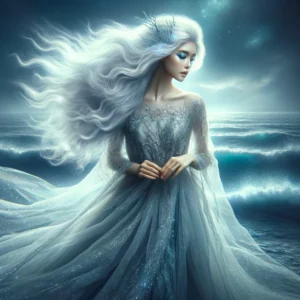Table of Contents
Fand, the name that evokes images of mystical seas, enchanting beauty, and divine power, is a fascinating figure in Irish mythology. This elusive and enigmatic sea goddess has captured the imaginations of many with her ethereal charm and intriguing tales.
Origins and Family
Fand, often referred to as “Fand of the Silver Braid,” is believed to be one of the Tuatha Dé Danann, a supernatural race in Irish mythology. She is the daughter of Aed Abrat and the sister of another well-known figure, the warrior Cú Chulainn. Fand’s divine lineage places her among the ranks of deities who played pivotal roles in the tales of ancient Ireland.
Appearance
Fand’s most iconic feature is her radiant silver hair, which flows like a shimmering waterfall down her back. Additionally, her silver locks are often depicted as long and lustrous, giving her an ethereal and otherworldly quality. Furthermore, this distinctive attribute sets her apart and is a symbol of her connection to the sea.
Moreover, her eyes are often described as the color of the deep sea, typically shimmering with a mesmerizing hue reminiscent of the ocean’s depths. This feature emphasizes her affinity with the waters and adds to her captivating allure.
Furthermore, Fand’s skin is sometimes depicted as having an almost translucent or porcelain-like quality, highlighting her otherworldly nature and contributing to her mesmerizing appearance.
In addition to her physical attributes, Fand is renowned for her exceptional beauty that goes beyond the superficial. Her presence is said to exude an enchanting aura that captivates all who gaze upon her. Moreover, her beauty is often described as otherworldly, almost divine, and has the power to draw mortals and immortals alike under her spell.
Lastly, in various depictions and stories, Fand is often described wearing a flowing gown made of the finest silks. This gown is said to shimmer with the same silvery hue as her hair, further emphasizing her connection to the sea and enhancing her overall allure. Moreover, she is often depicted as a graceful and elegant figure, moving with a fluid and almost ethereal quality. Her movements are described as mesmerizing, matching the enchanting beauty she radiates.

Abilities
Fand possesses a wide array of mystical abilities that set her apart as a formidable and alluring sea goddess:
Control Over the Sea: Fand holds dominion over the waters, granting her the power to calm raging storms or conjure tempestuous waves at will. She can manipulate the tides and currents, making her a force to be reckoned with on the high seas.
Healing Touch: Fand is renowned for her ability to heal wounds and ailments, especially those incurred in battles. Her touch can soothe pain and mend injuries, making her a sought-after figure in times of war and strife.
Shape-Shifting: Like many mythical beings, Fand possesses the power to transform her appearance at will. She can take on the form of various sea creatures, allowing her to move freely in the depths of the ocean or interact with the denizens of the deep.
Enchantment and Charisma: Fand’s ethereal beauty is not just skin-deep; it radiates an enchanting aura that can captivate the hearts of mortals and immortals alike. Her voice is said to be as melodious as a siren’s song, drawing all who hear it under her spell.
Weaknesses
Despite her formidable powers, Fand is not without vulnerabilities:
Emotional Sensitivity: Fand is known to be emotionally sensitive, and her mood can influence the temperament of the sea. When she is content, the waters remain calm, but her anger or sorrow can stir up storms and perilous currents.
Jealousy: In some stories, Fand’s romantic entanglements and jealousy have caused discord and conflict among both mortals and immortals. Her passionate nature can be a double-edged sword.
Behavior with Humans

Fand’s interactions with humans vary depending on the tales that feature her. In some stories, she is portrayed as a benevolent deity who aids and heals those in need. Warriors often seek her favor before embarking on perilous sea journeys, hoping for her protection and guidance.
However, Fand’s romantic entanglements with mortals have also been a source of turmoil. The most famous of these involves her brief but intense affair with Cú Chulainn, a hero of Irish mythology. Their passionate relationship sparked a conflict that reverberated through the ancient legends, revealing the complexities of her interactions with humans.
Symbols Representing Fand
The Silver Braid: Fand’s most iconic symbol is her shimmering silver hair, often depicted as a flowing braid. It symbolizes her connection to the sea and her otherworldly beauty.
The Ocean Waves: The undulating waves of the sea are another symbol associated with Fand. They represent her control over the waters and the ever-changing nature of her emotions.
A Healing Hand. A hand with the ability to heal represents Fand’s benevolent aspect and her role as a healer.
Myths and Stories
Fand’s most famous appearance in Irish mythology is in the tale of her love affair with Cú Chulainn. In this captivating story, Fand falls in love with the hero while he is away from his wife, Emer.
The Forbidden Love of Fand and Cú Chulainn

In Irish mythology, Fand’s tale revolves around her forbidden love affair with the hero Cú Chulainn, while he is separated from his wife, Emer. Fand, the ethereal sea goddess, fell deeply in love with the mortal warrior’s valor and charm.
As the story goes, Cú Chulainn, renowned for his martial prowess, embarked on a perilous journey to the Land of Shadows, where he encountered Fand and her enchanting beauty. Their attraction was immediate and intense, igniting a passionate and secret romance that unfolded amidst the waves and mists of the sea.
When word of their affair reached Cú Chulainn’s wife, Emer, she was understandably furious and heartbroken. Consequently, she confronted her husband, demanding that he end his liaison with the alluring sea goddess. In the midst of this turmoil, Cú Chulainn found himself in a painful and complex dilemma, torn between his loyalty to Emer and his overwhelming love for Fand
The situation grew even more complicated when Cú Chulainn’s friend and ally, the great warrior Fergus mac Róich, intervened to mediate the conflict. Fergus offered a solution: Cú Chulainn would return to Emer, and Fand would return to the sea, preserving the harmony of their respective worlds.
Fand, heartbroken but understanding the importance of duty and loyalty, agreed to this resolution. She returned to the depths of the ocean, leaving Cú Chulainn with bittersweet memories of their passionate love affair. The hero, with a heavy heart, reunited with Emer, and the conflict between the two sisters came to an end.
This tale of forbidden love, duty, and sacrifice showcases the complexities of human and divine emotions in Irish mythology. Fand’s brief but intense romance with Cú Chulainn remains a poignant and enduring story of love’s power and the difficult choices it can entail.
Angus Og and the Sea Goddess Fand
In ‘The Dream of Angus,’ a captivating Irish myth, Fand takes center stage as the object of the god Angus Og’s passionate affection. Furthermore, Angus, the god of love and youth, becomes enamored with Fand after seeing her in a vivid dream. Her extraordinary allure and captivating beauty leave an indelible mark on his heart.
Driven by an insatiable desire to make Fand his own, Angus Og decides to embark on a quest to bring her from the sea to his realm. To accomplish this, he dispatches messengers, who are guided by the vivid image of Fand that lingers in his mind.
The messengers venture to the shores of the sea. Upon their arrival, they witness the goddess Fand in all her resplendent glory. Moreover, her silver hair glistens like moonlight on the water, and her sea-colored eyes hold a depth of beauty that surpasses mortal comprehension. Mesmerized by her presence, they approach her with Angus Og’s proposal.

Fand, though flattered by the attention of a deity, remains steadfast in her connection to the sea. She gracefully declines Angus Og’s advances, explaining that her heart and destiny lie beneath the waves, where her powers and purpose are intertwined with the ocean’s depths.
The messengers return to Angus Og with Fand’s response, conveying her unwavering devotion to the sea. Despite his divine status and the intensity of his love, Angus Og recognizes the depth of Fand’s connection to her domain and accepts her decision with grace.
“The Dream of Angus” serves as a testament to the irresistibility of Fand’s beauty and the power of her bond with the sea. It underscores the theme of unrequited love and the understanding that even a deity’s desire may be bound by the forces of fate and destiny.
Similarities
Sirens: Fand’s enchanting voice and ability to captivate those who hear it bear a resemblance to the sirens. Sirens are known for luring sailors to their doom with their alluring songs.
Nymphs: Fand’s connection to the natural world and her ethereal beauty parallel the characteristics of nymphs in various mythologies. Nymphs are often associated with specific natural elements and are renowned for their beauty.




